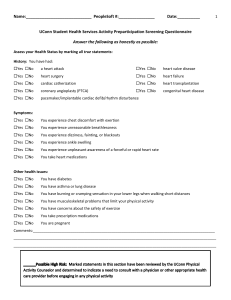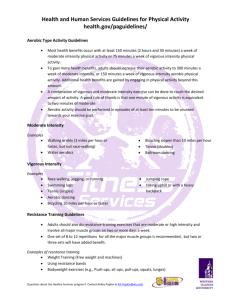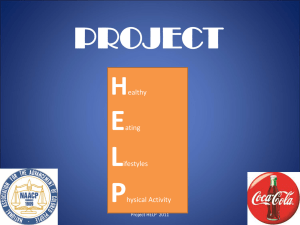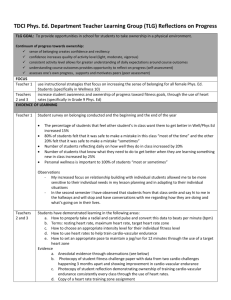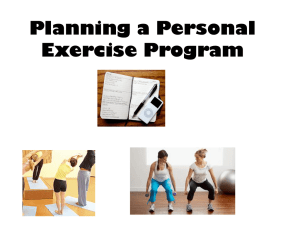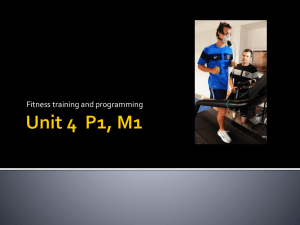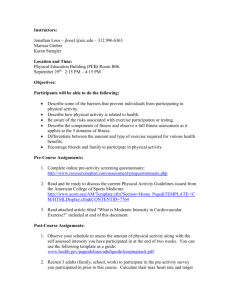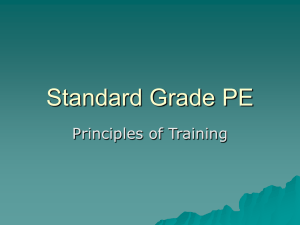Introducing Physical Activity
advertisement
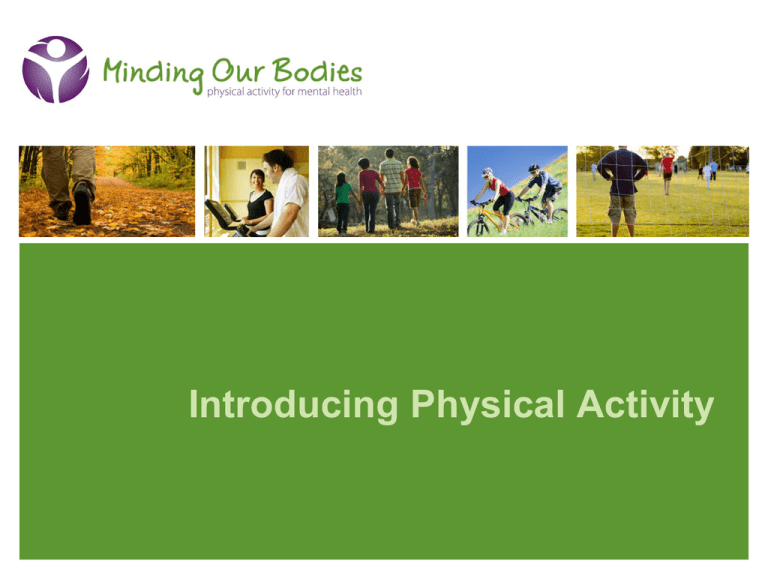
Introducing Physical Activity Minding Our Bodies is… An initiative of the Canadian Mental Health Association, Ontario In partnership with YMCA Ontario and York University, Faculty of Health A two-year project (2008-2010) With support from the Ontario Ministry of Health Promotion through the Communities in Action Fund What this workshop is about? Background Key terms and definitions Components of fitness Benefits of physical activity Principles of conditioning Monitoring Intensity Motivation What are the numbers? The majority (56%) of Canadians are inactive Two-thirds of Canadians strongly agree that a healthy lifestyle contributes to long-term health benefits The majority of Canadians fully intend to be active in the next six months Lack of time, energy and motivation are most frequently rated as important barriers to being active What is physical activity? Bodily movement produced by skeletal muscles that results in an energy expenditure and is positively correlated with physical fitness What is exercise? A sub-set of physical activity that is planned, structured and provides for repetitive bodily movement What is fitness? A set of attributes that people have or achieve relating to their ability to perform physical activity What is active living? A way of life in which physical activity is valued and integrated into daily life What are basics in Canada’s physical activity guide? Recommends 30-60 minutes of moderate physical activity daily Suggests adding up activities in periods of 10 minutes Gives great tips on getting started and how to make active living a part of your daily life www.paguide.com What are the components of fitness? Cardiovascular endurance Muscle endurance & strength Flexibility Balance & coordination Endurance Endurance (2 types) Cardiovascular: The ability to continue strenuous tasks that stress the circulatory and respiratory systems for long periods of time Muscular: The continuation or maintenance of muscular contraction until fatigue sets in Definitions Muscle strength: The force that a muscle can exert in a single contraction Flexibility: Range of motion at available at a joint Balance: The maintenance of equilibrium either with movement (dynamic) or no movement (static) Coordination: The ability to integrate movements involving different muscle groups into a single pattern Benefits of being active Helps build and maintain healthy bones, muscles, and joints and makes people with chronic, disabling conditions improve their stamina Promotes psychological well-being, reduces stress, anxiety and feelings of depression and loneliness Helps control weight and lower the risk of becoming obese by 50% compared to people with sedentary lifestyles Reduces the risk of dying prematurely Stress benefits Physical Activity reduces stress by… – promoting relaxation – providing a psychological distraction – changing mood – enhancing personal resources such as self-esteem and self-efficacy – providing time and opportunity to work through problems – generally regulating emotional and physiological reactions to a stressful event Wait…. There is more! Physical activity… – reduces the risk of developing heart disease or colon cancer by up to 50% – reduces the risk of developing type II diabetes 50% – helps to prevent / reduce hypertension Even more…. Physical activity… – helps to prevent / reduce osteoporosis – reduces the risk of developing lower back pain – can help in the management of painful conditions, like back pain or knee pain Start slowly and build up To improve your physical fitness, you should do a little more, a little: More often Harder Longer More safely This can be referred to as the FITT principle FITT Principle F – Frequency (how often) I – Intensity (how hard) T – Type (what kind of activity) T – Time (how long) Frequency Canada’s Guide to Physical activity recommends the following: 30-60 minutes of moderate physical activity daily Endurance – 4 to 7 days a week Flexibility – 4 to 7 days a week Strength – 2 to 4 days a week Intensity METs*(expend ed energy at res) % of max HR Examples Light intensity Medium Intensity Vigorous Intensity <3 3-6 >6 <64% 65-74% <75% strolling, stretching, gardening swimming, dancing, raking leaves jogging, basketball, hockey Type of activity Anything goes! Find a variety activities that you enjoy and stick to them Remember to choose activities that will improve the four components of fitness: endurance, flexibility, strength and balance Time The length of time will depend on the amount of effort – Light – 60 minutes – Moderate – 30-60 minutes – Vigorous – 20-30 minutes How hard do I work? Am I going fast enough? Talk Test Perceived Exertion Target Heart Rate Talk test Simplest of all the tests – Can I… Sing? (light intensity) Talk? (moderate intensity) Neither? (vigorous intensity) Perceived rate of exertion Rating Description 0 1 2 3 Nothing Very light Light (weak) Moderate 4 5 6 7 8 Somewhat hard Heavy (strong) 9 10 Very heavy Very, very heavy (near maximum) Perceived rate of exertion Based on “listening to your body” How hard is the activity for you? – Light intensity: 1-2 – Moderate intensity: 3-4 – Vigorous intensity: 5-6 Target heart rate Measures intensity, but can be inconvenient Maximum Heart Rate: (220 – age) x % (desired intensity) Example For a 30-year-old who wants to work out at a vigorous intensity (80%): Max HR = (220 – 30) x .80 = 152 Finding your THR To assess your heart rate: 1. Stop and find your pulse (use the carotid artery or the wrist) 2. Count the number of times your heart beats in 10 seconds 3. Multiply this by 6 to get your heart rate Compare your heart rate to your max heart rate – are you working hard enough? Too hard? Heart rate chart Barriers (individual) Most common barriers: Lack of time Lack of energy Lack of motivation Cost Barriers for some with mental illness Social isolation Stigma Fear of injury/not having the skill Transportation Cost Ways to overcome individual barriers Add physical activity to your daily routine. – For example, walk or ride your bike to work or shopping, organize school activities around physical activity, walk the dog, exercise while you watch TV, park farther away from your destination, etc. Make time for physical activity. – For example, walk, jog, or swim during your lunch hour, or take fitness breaks instead of coffee breaks. Overcoming barriers Convince yourself that if you give it a chance, physical activity will increase your energy level; then, try it. Plan ahead. Make physical activity a regular part of your daily or weekly schedule and write it on your calendar. Overcoming barriers Invite a friend to exercise with you on a regular basis and write it on both your calendars. Join an exercise group or class. Environmental barriers Lack of facilities nearby Lack of safe places Insufficient programs Lack of a partner/support Lack of transportation Ways to overcome environmental barriers Select activities that require minimal facilities or equipment, such as walking, jogging, jumping rope, or calisthenics. Identify inexpensive, convenient resources available in your community (community education programs, park and recreation programs, worksite programs, etc.). Ways to overcome environmental barriers Visit the local shopping mall and walk for half an hour or more. Encourage exercise facilities to provide child care services. Ways to overcome environmental barriers Explain your interest in physical activity to friends and family. Ask them to support your efforts. Develop new friendships with physically active people. Join a group, such as the YMCA or a hiking club. Are you ready to be active? What stage are you? I am not currently … and am not thinking of doing so in the coming month. I am not currently … but I have thought about … I am not currently … but I plan to do so within the next month. I am currently … but have only been doing so for the past 6 months or less. I am currently … and have been doing so for 7 months or more. Staying motivated! Keep a diary. Note down how far you ran or the match score, your pulse, how you felt, etc. That way you can look back and see how you have improved over time. Collect inspiration. Inspirational stories from people who have achieved against the odds may help – if they can do it, so can you. Staying motivated! Remind yourself of the reasons that motivated you to start exercising in the first place. Visualisation. Picture yourself achieving your goal, and imagine what it will feel like. These images and feelings will help to motivate you to achieving them for real. Staying motivated! Enjoy it! Exercising releases chemicals in the brain, such as serotonin, that have a strong affect on your mood, helping reduce anxiety, stress and depression. So whenever you don’t feel like exercising, try to remind yourself how good you’ll feel afterwards How much did you learn? This is a fun quiz that could be provided at the end of educational session on physical activity. Take the Physical Activity Quiz to find out how much you know: http://www.phac-aspc.gc.ca/pau-uap/paguide/quiz/question1.html Where to find out more? Local information (e.g., YMCA) www.paguide.com www.active2010.ca www.participaction.com www.mindingourbodies.ca Questions?
